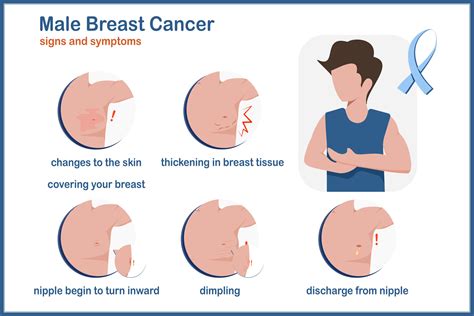What Are the Symptoms of Male Breast Cancer

Male breast cancer is a rare condition, but it demands your attention. Globally, it accounts for less than 1% of all breast cancer cases. In the United States alone, approximately 2,300 new cases were reported in 2017, with around 500 deaths. Early detection significantly improves survival rates. For localized cases, the five-year survival rate is 95%, while distant-stage cases drop to just 20%. Recognizing symptoms like lumps, nipple changes, or skin abnormalities can help you act quickly. Your awareness and prompt action could save your life.
Key Takeaways
Male breast cancer doesn’t happen often but is serious. Finding it early can save lives.
Usual signs are lumps, nipple changes, or odd skin issues. Watch for anything unusual.
Check yourself every month. This helps find problems early when treatment works best.
See a doctor if you have lumps, pain, or strange nipple discharge. Acting early helps treatment work better.
Family history and genes can raise your risk. Learn about your health and talk to a doctor if worried.
Common Symptoms of Male Breast Cancer

Lumps or Thickened Tissue
Characteristics of lumps
One of the most common signs of male breast cancer is the presence of a lump or thickened tissue in the breast area. These lumps often feel firm or hard and are usually painless. They may have irregular edges and remain fixed in one location. In some cases, the skin over the lump may appear dimpled, discolored, or thickened.
Characteristic | Description |
|---|---|
Location | Typically beneath or near the nipple or areola. |
Physical Traits | Firm or hard texture, usually painless, irregular edges, fixed location. |
Skin Changes | Possible dimpling, discoloration, or thickening over the lump. |
Lymph Node Involvement | May present as lumps under the arm (axilla). |
Common locations
Lumps associated with male breast cancer are most often found beneath the nipple or in the surrounding area. You may also notice swelling or lumps in the armpit, which could indicate involvement of nearby lymph nodes.
Changes in the Nipple
Nipple discharge
Nipple discharge is another symptom to watch for. This discharge can be clear or bloody and may occur without any external pressure on the nipple. While rare, it is a significant indicator that warrants medical attention.
Nipple inversion, rash, or scaling
Changes in the appearance of the nipple are also common. You might notice the nipple turning inward (inverted nipple), persistent rashes, or scaling around the nipple area. These changes can sometimes be accompanied by pain or irritation.
Nipple Change Type | Description |
|---|---|
Nipple pain | Pain experienced in the nipple area. |
Nipple turning inward | Nipple appears inverted. |
Nipple discharge | Fluid from the nipple, can be clear or bloody. |
Itchy, scaly sore or rash | Rash or irritation on the nipple. |
Skin Changes Around the Breast
Redness or flaky skin
Skin changes around the breast can provide early clues about male breast cancer. You might observe redness, irritation, or flakiness in the skin covering the breast or nipple. These changes often resemble skin conditions like eczema but should not be ignored.
Dimpling or puckering of the skin
Another key symptom is dimpling or puckering of the skin, which creates a texture similar to an orange peel. This occurs when the underlying tissue is affected, pulling the skin inward.
Skin Change Type | Description |
|---|---|
Redness | Commonly observed |
Flakiness | Skin may appear flaky |
Puckering | Skin may show puckering signs |
Dimpling | Characteristic texture change |
Tip: If you notice any of these symptoms, consult a healthcare professional promptly. Early detection of male breast cancer can significantly improve treatment outcomes.
Pain or Tenderness
When pain might indicate a problem
Pain or tenderness in the breast area can sometimes signal male breast cancer. While most cases of breast cancer do not cause pain, you should not ignore persistent discomfort. Pain that feels sharp, burning, or localized to one area may indicate an underlying issue. If the pain worsens over time or occurs alongside other symptoms like lumps or skin changes, it is essential to consult a healthcare provider.
You might also notice tenderness when pressing on the affected area. This tenderness could result from inflammation or changes in the breast tissue. Pay attention to how long the pain lasts and whether it interferes with daily activities. Persistent or worsening pain should always prompt medical evaluation.
Note: Occasional soreness or discomfort may not always mean cancer. However, consistent pain deserves attention.
Differentiating between normal soreness and concerning pain
Not all breast pain is a sign of male breast cancer. Normal soreness can occur due to physical activity, minor injuries, or hormonal changes. This type of pain usually resolves on its own within a few days. It often feels dull or achy and does not stay in one specific spot.
Concerning pain, on the other hand, tends to persist and may feel more intense. It might also come with other warning signs like swelling, redness, or changes in the nipple. If you notice these symptoms, take action immediately. Early detection can make a significant difference in treatment outcomes.
To help you differentiate, ask yourself these questions:
Does the pain last longer than a week?
Is the pain sharp or burning?
Do you notice other symptoms like lumps or skin changes?
If you answer "yes" to any of these, schedule a medical check-up without delay.
How to Perform a Self-Examination for Male Breast Cancer

Step-by-Step Guide
Visual inspection for changes in size, shape, or skin texture
Start by standing in front of a mirror. Look closely at your chest for any changes in size, shape, or symmetry. Pay attention to swelling, dimpling, or unusual skin texture. Examine the nipple area for redness, scaling, or inversion. These visual cues can help you identify early signs of male breast cancer.
Palpation techniques to check for lumps or abnormalities
Use your fingertips to feel for lumps or thickened tissue. Lie down on a flat surface to make the examination easier. Move your fingers in small circular motions, applying light, medium, and firm pressure. Cover the entire breast area, including the armpit and breastbone. Gently squeeze each nipple to check for any fluid discharge. This thorough approach ensures you don’t miss any abnormalities.
Tip: Perform the examination in a systematic pattern, such as moving from the outer edge of the breast toward the nipple.
Frequency of Self-Examinations
Recommended intervals for self-checks
If you are at high risk for male breast cancer, perform a self-examination every month. Regular checks help you detect changes early, when treatment is most effective. Consult your doctor to determine the best schedule based on your risk factors.
Importance of consistency in monitoring changes
Consistency is key to understanding what is normal for your body. Regular self-examinations allow you to notice subtle changes in your breast tissue. Inconsistent checks may delay the detection of cancer, leading to a more advanced stage at diagnosis. Early detection improves the chances of successful treatment and better outcomes.
Reminder: If you notice any unusual changes, consult a healthcare provider immediately.
When to Seek Medical Attention
Persistent or Worsening Symptoms
Signs that require immediate medical evaluation
Certain symptoms should prompt you to seek medical attention without delay. These include:
Pain or tenderness in the breast area.
Changes in the nipple, such as inversion, redness, or discharge (clear or bloody).
Skin changes over the breast, like dimpling, discoloration, or puckering.
Unexplained nipple discharge, especially if it’s bloody.
A lump that persists or grows over time.
These signs may indicate male breast cancer or another serious condition. Acting quickly can make a significant difference in your health outcomes.
Why ignoring symptoms can be dangerous
Delaying medical attention can have severe consequences. Studies show that about 40% of men with breast cancer are diagnosed at stage 3 or 4, when the disease has already spread. This late diagnosis often results from a lack of awareness or ignoring early symptoms. Survival rates drop significantly as the cancer progresses. For instance, the five-year survival rate for localized male breast cancer is 95%, but it falls to just 20% for distant-stage cases. Early detection is crucial for improving your chances of successful treatment.
Family History and Risk Factors
Genetic predispositions (e.g., BRCA mutations)
Your family history plays a critical role in assessing your risk. Approximately 20% of men with breast cancer have a close relative who also had the disease. Genetic mutations, particularly in the BRCA1 and BRCA2 genes, further increase your risk. Men with BRCA2 mutations face a lifetime breast cancer risk of 6.8%, compared to 1.2% for those with BRCA1 mutations. If your family carries these mutations, consider genetic testing and counseling to understand your risk better.
Other risk factors like age or hormone levels
Age and hormone levels also influence your risk. Male breast cancer typically occurs in older men, with most cases diagnosed after age 60. Elevated estrogen levels, often caused by conditions like obesity or liver disease, can also increase your risk. Understanding these factors can help you take preventive measures and stay vigilant.
Diagnostic Tests for Male Breast Cancer
Common diagnostic procedures (e.g., mammograms, biopsies)
Doctors use several tests to diagnose male breast cancer. A diagnostic mammogram is often the first step, providing detailed X-ray images of the breast tissue. If abnormalities are found, a biopsy is performed to confirm the presence of cancer. This involves removing a small tissue sample for microscopic examination. Other tests, like breast ultrasounds or fine needle aspirations, may also be used to evaluate suspicious areas.
How early diagnosis improves treatment options
Early diagnosis opens the door to more effective treatment options. When detected early, treatments like surgery or radiation therapy can often remove or destroy the cancer completely. Late-stage diagnoses, however, may require more aggressive treatments like chemotherapy, which can have more side effects. By addressing symptoms promptly, you increase your chances of a successful outcome and a higher quality of life.
Male breast cancer is rare but demands your attention. Recognizing symptoms like lumps, nipple changes, or skin abnormalities early can save lives. Regular self-examinations play a vital role in detecting changes, such as thickened tissue or unusual discharge, before the disease progresses. Monthly checks help you stay aware of your body and act promptly if needed. If you notice any concerning signs, consult a healthcare professional immediately. Awareness and vigilance are your best tools for early detection and effective treatment.
Remember: Early detection improves survival rates and treatment outcomes.
FAQ
What is the first symptom of male breast cancer you should look for?
The first symptom you should notice is usually a lump or thickened tissue in the breast area. It often feels firm and painless. Check beneath the nipple or near the armpit for any unusual changes.
Can men get breast cancer without a family history?
Yes, men can develop breast cancer even without a family history. Other factors like age, hormone levels, or lifestyle choices can increase your risk. Always monitor your body for changes, regardless of your family history.
How common is male breast cancer?
Male breast cancer is rare, accounting for less than 1% of all breast cancer cases. However, it is still a serious condition. Early detection improves survival rates significantly, so stay vigilant for symptoms.
Is breast pain always a sign of cancer?
No, breast pain is not always cancer. It can result from injuries, infections, or hormonal changes. However, persistent or worsening pain, especially with other symptoms like lumps or skin changes, should prompt you to see a doctor.
Can male breast cancer be cured?
Yes, male breast cancer can often be treated successfully if detected early. Treatments like surgery, radiation, or chemotherapy can remove or destroy cancer cells. Early diagnosis gives you the best chance for a full recovery.
Tip: If you notice any unusual symptoms, consult a healthcare provider immediately. Early action saves lives.
---
ℹ️ Explore more: Read our Comprehensive Guide to All Known Cancer Types for symptoms, causes, and treatments.
See Also
Identifying The Signs Of Appendix Cancer You Should Know
Understanding The Symptoms And Triggers Of Breast Cancer
Recognizing The Symptoms And Factors Of Gallbladder Cancer
